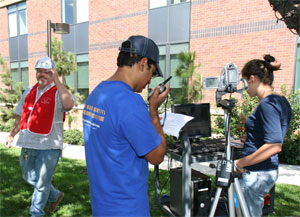Drill Provides Test Bed for New Technology
|
Irvine, Calif. Sept. 29, 2008 -- A recent emergency drill on the UCI campus emptied the Calit2 Building and neighboring Bren Hall. In reality it was a technology-integration exercise that allowed Calit2-affiliated researchers to assess developing firefighter-safety systems.
Researchers are calling the data communications system SAFIRE (Situational Awareness for Firefighters). Funded by a $1 million Fire Prevention and Safety grant from FEMA, project PI Sharad Mehrotra and co-PI Nalini Venkatasubramanian wanted to put their current efforts to the test.
By working in tandem with the UCI Police Department, the researchers were able to schedule the evacuation drill to simulate real-life procedures. As students, faculty and employees filed out of both buildings, researchers tracked the progress and safety of four “firefighters” using software and some hardware they had developed.
They set up a “command center” next to Bren Hall, on the University Club lawn. Using mesh routers, they established a Wi-Fi hot spot where they were able to upload information arriving from multiple sources.
The battery-powered routers, adapted from commercial products manufactured for military applications, contain two radios: one provides a Wi-Fi bubble so first-responder sensor data can be easily uploaded, and the other supplies backhaul connectivity to the Internet in order to make the data widely available. The routers have been designed to plug into existing Ethernet connections or connect to high-speed wireless broadband using EVDO cards. All the routers – whether there are two or 50 – can mesh with each other, carrying the data in “hops” from one to the next until it reaches its destination.
|
||||
The pseudo firefighters wore sensors that recorded temperature, heart rate, acceleration, light, humidity and location. They also deployed two portable self-contained optical/acoustic sensors that relayed video and sound over Wi-Fi. Cameras and sensors in the two “smart” buildings registered their own data, and all of the information was relayed to the makeshift command center.
By using their incident command board software, researchers were able to integrate all the data streams and see the event in a more comprehensive way.
In the scenario they developed, a delivery person transporting material to the Calit2 loading dock inadvertently spilled toxins on himself. After calling 911, he attempted to find help, ultimately staggering into Bren Hall and collapsing.
“There are actually two incidents going at once. The software’s got to be smart enough so that when the second thing happens – someone finds him unconscious in Bren Hall – it will recognize that these two incidents are correlated,” said software engineer Jay Lickfett.
In addition to the routers and software, a new instrument was tested in the drill. Chris Davison, ResponSphere technology manager, devised a portable device containing a tiny sensor that can measure firefighters’ heart rates and relay the information to the command center. The software will be programmed to immediately recognize deviations from the norm and sound an alert.
“Firefighters now carry equipment that will sound an alarm that alerts anyone close to them if they stop moving for a certain length of time, or if the temperature reaches a certain threshold, or if they fall over. If no one is near them at the time, you have the ‘tree falling in the forest’ problem. But this system will allow that information to go straight to the command center,” Davison said.
Researchers are incorporating similar parameters for other sensors – in essence, teaching the software how to recognize deviations in firefighters’ typical acceleration, position, light, sound and other markers that allow it to sound an alarm when those factors change drastically.
SAFIRE software will incorporate other important safety features. During an emergency, field commanders using the system will have the ability to immediately upload important information. The system will automatically check its databases and provide a list of relevant data for first-responders to select from: building floor plans, occupancy data from the incident site, the location of toxic chemicals, etc.
“Our idea is to incorporate more live information than current physical systems provide, using cameras and smart-building sensors,” said Lickfett. “We also want to make the process more seamless so the fire department can easily access necessary information.”
Researchers also are studying radio communications in an effort to reduce the impact of background noise and other distractions. Their goal is to capture speech and other sounds made by firefighters and convert the audio into a text transcript or alert messages at the command post.
The SAFIRE team considered the exercise a success. “It was our first integration test of all the pieces of SAFIRE under drill conditions and all the major components being tested worked,” said Lickfett.
The drill did bring to light some challenges related to establishing a robust networking infrastructure. “It is very difficult to bring in a completely new network and get good coverage inside a building,” he said.
In addition, unreliable networking can impact the ability of the system to cope with sometimes undependable sensing. “The integrated approach taken by the [software] to fuse information from multiple sources is helpful, however, since it can help determine when data from an individual type of sensor is unreliable,” said Venkatasubramanian.
Information gathered during the exercise helped the team identify the next level of research. “Our data collection was successful and will be very useful to us as we prioritize the next phase of development work,” Lickfett summarized.



